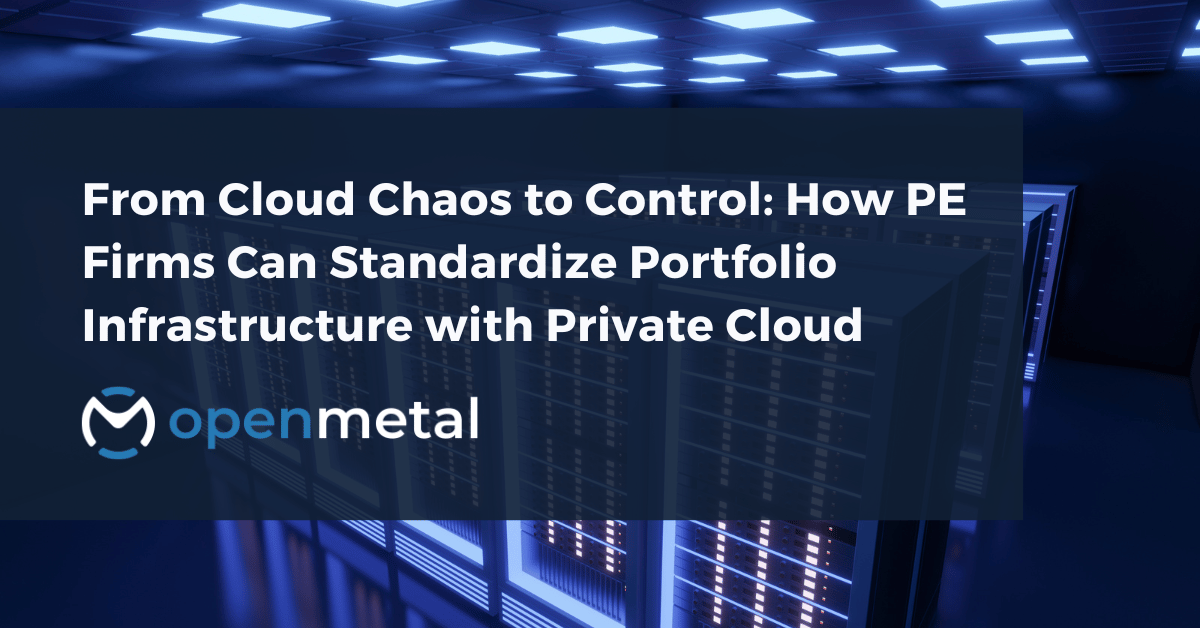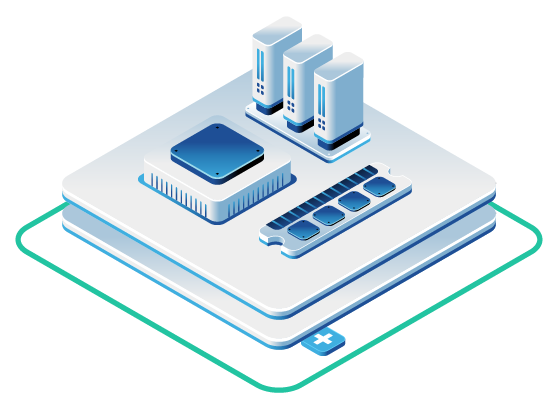
Managing infrastructure across a portfolio of SaaS companies often feels like herding cats. One portfolio company burns through AWS credits on oversized instances, another struggles with Azure’s complex billing, while a third maintains expensive co-location contracts that made sense five years ago but now drag down margins. For private equity operating partners, this fragmentation creates headaches in cost control, performance monitoring, and strategic planning. The challenge isn’t just financial, it’s operational.
When each portfolio company runs different infrastructure stacks with unique billing models, usage patterns, and management interfaces, your team can’t apply consistent governance, implement best practices across holdings, or identify optimization opportunities at scale. Research from Andreessen Horowitz reveals that $100 billion of market value is being lost among the top 50 public software companies due to cloud impact on margins1. For PE firms managing SaaS portfolios, this represents a massive value creation opportunity that’s hiding in plain sight, but only if you can bring consistency to how portfolio companies approach infrastructure.
The Hidden Cost of Infrastructure Fragmentation
Across PE portfolios, infrastructure sprawl creates problems that extend far beyond monthly bills. Each different platform requires specialized knowledge, creates unique failure modes, and generates distinct cost patterns that make portfolio-level optimization nearly impossible.
Usage-Based Pricing Unpredictability
Public cloud costs can reach 50% of total cost of revenue for software companies, and actual spend typically exceeds committed spend by significant margins. This unpredictability makes financial planning difficult across your portfolio, especially when trying to model EBITDA improvements or establish consistent margin targets.
The fundamental problem is that usage-based pricing directly ties infrastructure costs to business growth, often faster than the revenue those customers generate. When your SaaS companies acquire new customers or process more data, infrastructure costs increase immediately, creating margin pressure precisely when companies should benefit from scale economics.
Resource Waste Across Multiple Platforms
In typical public cloud deployments, workloads use roughly 30% of allocated resources on average and burst to use no more than 30% more over time, leaving approximately 40% of VM resources wasted. Yet you still pay for 100% of those allocated resources whether you use them or not.
This waste compounds when managing multiple portfolio companies across different platforms. Your development team at Company A over-provisions AWS instances to avoid performance issues, while Company B’s engineering team does the same thing on Azure, and Company C maintains underutilized co-location hardware. You’re paying for inefficiency three different ways with three different billing models.
Management Complexity at Portfolio Scale
Many companies resist making the changes and investments needed for a move to cloud, often burdened with tech debt and comfortable with the if-it-ain’t-broke-don’t-fix-it mindset. This resistance creates a portfolio where some companies run modern cloud infrastructure while others maintain legacy systems that require specialized knowledge to manage.
For PE operating partners, this fragmentation means you can’t implement consistent security policies, performance monitoring, or cost optimization strategies across your holdings. Each platform requires different expertise, generates different metrics, and responds to different optimization approaches.
Why Private Cloud Solves the Standardization Problem
Private cloud infrastructure addresses portfolio fragmentation by providing a consistent platform that behaves like public cloud but with predictable costs, dedicated resources, and standardized management interfaces. For PE firms, this creates the opportunity to implement uniform infrastructure governance across all portfolio companies without forcing each team to learn new platforms or change their operational approaches.
Predictable Cost Structure Across Holdings
OpenMetal provides hosted private cloud infrastructure with fixed monthly pricing tied to hardware configuration rather than usage metrics. Costs are not usage-based, and egress is billed at $375 per Gbps using 95th percentile averaging. For PE firms, this creates predictable infrastructure spending across portfolio companies and avoids the variable costs that often make financial reporting and forecasting difficult.
This pricing model eliminates the billing surprises that make portfolio-level budgeting challenging. Instead of managing dozens of different cost variables across your portfolio companies, you can model infrastructure as fixed costs that scale predictably with business growth rather than fluctuating with daily usage patterns.
Rapid Deployment Without Operational Complexity
A minimum deployment starts with a three-server Cloud Core that combines compute and Ceph storage. Clusters deploy in about 45 seconds and can be expanded in approximately 20 minutes. This deployment speed matches public cloud convenience while providing dedicated infrastructure that eliminates the noisy neighbor problems that can impact application performance.
Each server includes dual 10 Gbps uplinks on both private and public networks. Private networking includes isolated VLANs with unmetered traffic between servers. This networking approach allows portfolio companies to architect applications without worrying about data transfer charges between components.
Standardized Management with Operational Flexibility
Within each cluster, OpenStack Virtual Private Clouds (VPCs) can be created for logically isolated environments managed through the OpenStack interface. This gives portfolio companies independent environments while allowing PE operations teams to apply consistent policies across all holdings.
Management is available through the OpenMetal Central dashboard, OpenStack APIs, and CLI tools, enabling engineer-to-engineer oversight while still allowing portfolio companies to manage their own operations. Your teams get familiar interfaces that work consistently across all portfolio companies, reducing the learning curve and operational complexity.
Right-Sizing Infrastructure for Portfolio Diversity
Portfolio companies typically have different workload profiles, growth stages, and resource requirements. Rather than forcing every company into identical infrastructure configurations, private cloud allows you to standardize the platform while customizing the hardware to match specific needs.
Scalable Hardware Options for Different Company Stages
Hardware options include Medium V4 servers with dual Intel Xeon Silver 4510 CPUs and 256 GB DDR5 memory, suitable for smaller SaaS companies or development environments. Large V4 servers with dual Intel Xeon Gold 6526Y CPUs and 512 GB DDR5 memory handle production workloads for growing companies.
For compute-intensive applications, XL/XXL V4 servers with dual Intel Xeon Gold 6530 CPUs support 1 TB to 2 TB DDR5 memory. These options allow portfolio companies with different workload profiles—whether moderate SaaS environments, data-intensive platforms, or large-scale analytics—to standardize on consistent infrastructure types rather than managing a mix of unrelated systems.
Specialized Infrastructure Within the Same Platform
Specialized infrastructure is also available. GPU servers provide dedicated compute resources for companies building AI or machine learning capabilities, and Ceph storage clusters allow large-scale, resilient storage for data-heavy applications. For PE firms, this means advanced workloads can still fit within the same standardized infrastructure approach, reducing fragmentation across the portfolio.
Storage-optimized servers combine NVMe cache with enterprise HDDs, providing the performance characteristics needed for databases and analytics workloads while maintaining the cost efficiency required for long-term data retention. This unified storage approach eliminates the complexity of managing multiple storage services across different platforms.
Geographic Distribution for International Portfolios
OpenMetal operates data centers in Los Angeles, Ashburn, Amsterdam, and Singapore. This provides geographic flexibility for international portfolios while maintaining a consistent platform. Portfolio companies can operate closer to their customers without requiring different infrastructure management approaches or billing models.
For PE firms with international holdings, this geographic distribution means you can implement consistent infrastructure policies across regions while ensuring each portfolio company meets local performance and compliance requirements.
Portfolio-Level Value Creation Through Infrastructure Standardization
The financial impact of cloud repatriation extends beyond monthly cost reductions to fundamental improvements in SaaS company financial profiles. For PE firms focused on EBITDA growth and exit valuations, standardizing infrastructure creates measurable value that compounds across the entire portfolio.
Direct Cost Impact Across Multiple Companies
Converting variable cloud costs to fixed private cloud expenses typically reduces total infrastructure spending by 30-50% for SaaS companies with predictable workloads. For a portfolio company spending $2 million annually on public cloud infrastructure, this represents $600,000 to $1 million in direct cost savings that flows immediately to EBITDA.
When applied across an entire portfolio, these savings compound significantly. If you’re managing five portfolio companies with substantial cloud spending, coordinated infrastructure optimization can deliver millions in annual cost savings and tens of millions in increased valuations at exit.
Improved Financial Forecasting and Planning
Predictable infrastructure costs enable more accurate EBITDA forecasting across your portfolio and eliminate the margin compression that occurs when infrastructure costs scale faster than revenue. CFOs can model infrastructure expenses as fixed costs rather than variables that fluctuate with business performance.
The ROI is immediate — there’s no more maintenance or server space cost and a reduced need for day-to-day IT support. This predictability becomes particularly valuable during fundraising or exit processes, where consistent margins and clear cost structures enhance company valuations.
Operational Efficiency Through Consistent Processes
When your entire portfolio runs on the same infrastructure platform, your operations team can develop expertise once and apply it across all holdings. This creates efficiencies in monitoring, troubleshooting, optimization, and strategic planning that wouldn’t be possible with fragmented infrastructure approaches.
You can implement consistent security policies, backup procedures, and performance monitoring across all portfolio companies. Best practices discovered at one company can be immediately applied to others, creating a portfolio-wide learning effect that improves performance across all holdings.
Implementation Strategy for Portfolio Infrastructure Standardization
Successful infrastructure standardization requires systematic assessment and phased implementation across portfolio companies. The most effective approaches follow proven methodologies that minimize risk while maximizing financial impact.
Identifying Optimization Candidates
Not every portfolio company benefits equally from infrastructure standardization. The best candidates typically have annual cloud spending approaching $1 million or more, predictable workload patterns with consistent resource requirements, and cloud costs representing 50% or more of cost of revenue.
Companies approaching diligence phases particularly benefit from infrastructure optimization, as improved gross margins and predictable cost structures enhance valuations during the evaluation process. Applications requiring consistent performance characteristics—such as real-time processing or customer-facing APIs with strict SLA requirements—benefit from dedicated resources and predictable latency.
Phased Migration Approach
Rather than attempting to migrate all portfolio companies simultaneously, successful transitions often begin with development and staging environments. This allows teams to build familiarity with the new platform before transitioning customer-facing systems.
Production workloads with predictable resource requirements represent the next logical candidates for migration. Data-intensive applications often see the largest improvements, as these workloads frequently trigger significant egress charges in public cloud but operate efficiently within private cloud environments.
Building Migration Support Infrastructure
Migration support should include engineer-assisted onboarding that helps portfolio companies plan and execute transitions without disrupting customer-facing services. This support covers architecture review, migration planning, and performance optimization to ensure applications operate efficiently in the new environment.
Direct access to infrastructure engineers provides ongoing support that reduces the operational burden on portfolio company teams. This support model allows SaaS companies to benefit from private cloud economics without requiring significant increases in internal infrastructure expertise.
Making Infrastructure a Strategic Asset
As more startups discover that the cloud’s biggest feature—elasticity—can also be its biggest trap, this trend will only grow. For PE-backed SaaS companies, treating infrastructure as a strategic asset rather than just an operational expense creates sustainable competitive advantages.
Performance Consistency as Competitive Differentiation
Dedicated infrastructure resources provide performance consistency that can become a product differentiator, particularly for enterprise SaaS offerings where reliability and responsiveness directly impact customer satisfaction and retention rates. When your entire portfolio operates on consistent infrastructure, you can guarantee performance characteristics that become part of your companies’ value propositions.
Cost Structure as Competitive Moat
Predictable infrastructure costs enable more aggressive pricing strategies and higher gross margins across your portfolio companies. SaaS companies with efficient infrastructure can invest more in product development, sales, and marketing while maintaining healthy unit economics that compound over time.
Infrastructure consistency creates sustainable competitive advantages that extend beyond individual portfolio companies. When your entire portfolio operates more efficiently than competitors, you create systematic value that enhances both current cash flow and exit valuations.
The Strategic Imperative: From Fragmentation to Standardization
For PE firms managing SaaS portfolios, infrastructure standardization represents more than tactical cost optimization—it’s a strategic repositioning that improves financial performance while reducing operational complexity. The choice isn’t between different infrastructure approaches; it’s between continued fragmentation that limits portfolio-level optimization and standardization that creates systematic value creation opportunities.
Portfolio infrastructure standardization delivers measurable EBITDA improvements through cost reduction, margin predictability, and operational efficiency. More importantly, it creates a framework for applying best practices across all holdings and capturing value that would remain invisible in fragmented infrastructure approaches.
The most successful PE firms are recognizing infrastructure optimization as a systematic value creation opportunity that delivers immediate financial benefits while positioning portfolio companies for premium exit valuations. By converting variable infrastructure costs into predictable fixed expenses across the entire portfolio, you create sustainable competitive advantages that compound over time.
For portfolio companies spending significant amounts on disparate infrastructure platforms, the question isn’t whether to evaluate standardization—it’s how quickly you can implement strategies that convert infrastructure complexity into competitive advantages.
Ready to evaluate how private cloud standardization can improve efficiency and EBITDA across your portfolio? Explore OpenMetal’s PE firm program →
[1] Andreessen Horowitz. “The Cost of Cloud: A Trillion Dollar Paradox.”
Read More on the OpenMetal Blog


































